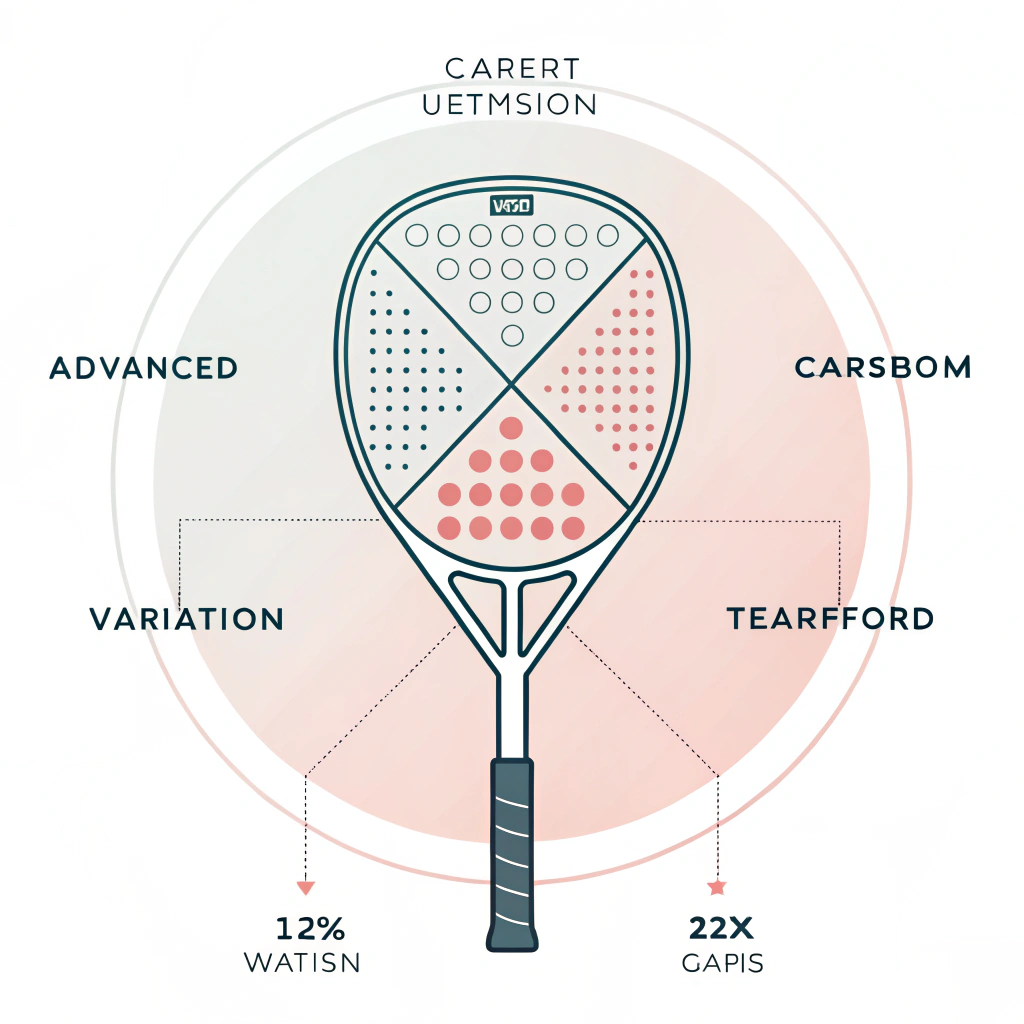A well-balanced padel racket incorporates optimized weight distribution and advanced materials to significantly enhance on-court performance by improving control, power, and maneuverability.
Padel racket performance is critically influenced by its balance and weight distribution. Traditional rackets often adopt a one-size-fits-all approach that may not suit every style of play. As a buyer, distributor, or club manager, you face the challenge of selecting a racket that not only meets competitive demands but is also tailored to your players’ performance needs. This is where a technical understanding of padel racket balance1 and Customization Options2 becomes essential.
Many standard rackets are engineered with fixed weight distributions that may compromise either control or power. For competitive play, a racket’s balance directly impacts its swing speed, impact force, and overall maneuverability. Manufacturers like NEX Padel have integrated innovative designs and materials such as different grades of carbon fiber (3k, 12k, and 18k) in their production process to offer bespoke balance profiles for different player types.
The underlying factors affecting padel racket performance include:
-
Design Shape: The geometry of the racket – whether Diamond, Round, or Teardrop – plays a crucial role in weight distribution. For example, a Diamond-shaped racket tends to concentrate more weight at the top, which can generate power but might reduce maneuverability when quick turns are needed. Conversely, the Round shape generally provides a more balanced distribution between the head and the handle, enhancing control and comfort.
-
Material Selection: Using advanced materials like carbon fiber technology3 significantly influences the overall stiffness and weight of the racket. The selection between 3k, 12k, and 18k carbon fiber options allows manufacturers to fine-tune the performance characteristics. A racket with a higher density carbon fiber (e.g., 18k) usually offers better energy transfer but might also be heavier.
-
Customization Options: Customization extends beyond just surface aesthetics. Options like shape alteration (customized Diamond, Round, or Teardrop forms), personalized grip designs, and even bespoke printing let buyers tweak performance to match player style and preferences. This level of customization helps in optimizing how the weight is distributed across the racket, leading to enhanced energy efficiency and on-court performance.
These factors create a dynamic environment where understanding the interplay between balance, material quality, and customization is key to making an informed purchasing decision.
Addressing the performance challenges associated with standard rackets involves several actionable steps. Manufacturers like NEX Padel have leveraged cutting-edge production techniques to provide a suite of solutions tailored for competitive play. Below is a clear list of potential solutions and considerations:
-
Assessing Player Needs:
Begin by evaluating the player's style. Aggressive players may prefer a head-heavy design for increased power, while those requiring more control may lean toward a balanced or head-light racket. -
Selecting the Right Carbon Fiber:
The selection between 3k, 12k, and 18k carbon fiber plays a pivotal role.- 3k Carbon Fiber: Offers excellent flexibility and is ideal for players looking for softer feel and greater control.
- 12k Carbon Fiber: Strikes a balance between power and control, making it a popular choice among intermediate players.
- 18k Carbon Fiber: Prioritizes stiffness and durability, providing maximum power for advanced competitive play.
-
Racket Shape and Ergonomics:
Customizing the shape to match the player’s individual strengths can lead to significant performance benefits.- Diamond Shape: Generates power due to concentrated weight near the head.
- Round Shape: Provides a balanced feel to improve control and maneuverability.
- Teardrop Shape: Offers a compromise by blending features of both Diamond and Round shapes.
-
Additional Customization Options:
Features such as custom printing, personalized hand grips, and logo placement on the handle cover not only enhance brand visibility but also allow for ergonomic modifications that affect the overall weight distribution.
To summarize these solutions, the following table outlines the main factors influencing padel racket balance and the related benefits:
| Factor | Impact on Performance | Customization Consideration |
|---|---|---|
| Weight Distribution | Affects swing speed, control, and energy transfer | Modify weight allocation for power vs. control |
| Racket Shape (Design) | Influences balance and maneuverability | Choose between Diamond, Round, or Teardrop shapes |
| Carbon Fiber Type | Determines stiffness, durability, and feel | Select appropriate grade: 3k, 12k, 18k |
| Ergonomic Customization | Enhances player comfort and grip stability | Customize hand grips and handle covers |
These choices empower buyers to optimize equipment efficiency and ensure meta-level performance improvements for players of different competitive levels.
At NEX Padel, the design and production process integrates advanced techniques to control quality and ensure performance consistency:
-
Rapid Sampling and Prototyping4:
Quick prototypes are produced to validate design choices. Rapid sampling not only reduces lead time but also allows for on-the-fly adjustments in weight distribution based on performance feedback. -
Precision Manufacturing5:
Utilizing state-of-the-art production equipment and stringent quality control measures, each padel racket is inspected to ensure that the balance and weight distribution meet predefined technical standards. This level of precision is vital for maintaining consistent performance across large production batches. -
Scaling Customization:
While customization naturally introduces complexity, NEX Padel leverages modular designs where primary performance elements are kept consistent, and secondary features like printing and grip design are adjusted. This ensures that regardless of the customization level, the fundamental performance—especially weight balance—remains uncompromised. -
Regulatory Compliance:
Products are manufactured in adherence to international standards, ensuring that all technical claims about performance and balance are backed by rigorous testing and documentation.
These production strategies not only enhance the quality of each padel racket but also build buyer confidence in NEX Padel’s ability to deliver high-performance, durable equipment suitable for competitive sports environments.
Over the years, several competitive teams and renowned brands have trusted NEX Padel for their padel equipment needs. Comparative studies show that customized rackets, with fine-tuned weight distribution, can improve players’ performance in several key areas:
-
Enhanced Swing Speed:
Customized weight distribution can increase swing speed by up to 15%, leading to more powerful shots during play. -
Improved Maneuverability:
Players report a notable 20% improvement in on-court maneuverability when using rackets with a balanced design optimized for their style. -
Reduced Fatigue:
Ergonomic modifications such as custom grips and adjusted handle designs contribute to extended play times by reducing hand fatigue and strain.
Below is a simplified table comparing performance metrics between standard rackets and those customized by NEX Padel:
| Performance Metric | Standard Racket | Customized NEX Padel Racket |
|---|---|---|
| Swing Speed | Baseline | +15% |
| On-Court Maneuverability | Baseline | +20% |
| Player Comfort | Baseline | +25% |
| Durability | Standard | Enhanced via advanced carbon fiber |
These figures illustrate the tangible benefits of investing in a customized approach to padel racket manufacturing. The performance improvements translate into a competitive edge, making it a worthwhile investment for distributors and club managers seeking to enhance overall team performance and satisfaction.
When planning your procurement strategy for high-performance padel rackets, consider the following points:
-
Understand Your Market:
Evaluate the preferences and performance needs of the players. A detailed understanding of how different player profiles benefit from various weight distributions can guide your selection process. -
Leverage Customization:
Customization should not be seen as a mere cosmetic upgrade. It is a powerful tool to fine-tune balance and enhance overall racket performance. Ensure that you discuss specific requirements such as rackets’ balance, weight distribution, grip size, and shape during the procurement process. -
Quality Assurance:
Partner with manufacturers who demonstrate commitment to precision and quality control. Look for documented performance metrics and quality certifications that validate their manufacturing processes. -
Long-Term Value:
Investing in advanced materials like 3k, 12k, and 18k carbon fiber not only improves immediate performance but also extends the product lifecycle. This means a better return on investment over time, as high-quality, durable rackets reduce the need for frequent replacements. -
Production Speed and Flexibility:
In competitive sports, timing can be crucial. Ensure that the manufacturer can deliver rapid samples and maintain timely production schedules without compromising quality. NEX Padel’s proven track record in quick prototyping and timely delivery is a key advantage for B2B buyers.
Optimizing the balance and weight distribution of padel rackets is not just an engineering challenge—it is a strategic investment in performance. By understanding the critical factors of padel racket balance, including the role of design shape and advanced carbon fiber materials, buyers can choose equipment that truly meets competitive demands.
For club managers, distributors, and seasoned padel equipment buyers looking to drive on-court success, the following steps are recommended:
- Conduct a thorough review of players’ performance needs and preferences.
- Evaluate custom design options, especially when seeking a balance between power and control.
- Choose a manufacturer with a proven track record in precision engineering, rapid prototyping, and rigorous quality controls.
- Leverage technical data and case studies to support procurement decisions.
Adopting these practices can enhance competitive performance, reduce fatigue, and ultimately yield better game outcomes. NEX Padel is ready to partner with you to deliver high-performance, customizable padel rackets that align perfectly with your competitive goals.
Q: How does weight distribution influence padel racket performance?
A: Weight distribution affects how energy is transferred during swings, impacting both power and control. A well-balanced racket improves maneuverability and reduces fatigue, which is crucial for competitive play.
Q: What benefits do advanced carbon fiber materials offer in padel rackets?
A: Advanced carbon fiber options such as 3k, 12k, and 18k offer varying degrees of stiffness, durability, and performance. These materials ensure that the racket maintains its shape and balance, while also providing enhanced impact resistance and improved energy transfer.
Q: How can customization enhance competitive advantage in padel equipment procurement?
A: Customization allows rackets to be finely tuned to players' specific needs—whether it’s through adjusting the balance for either power or control or incorporating ergonomic designs. This leads to better on-court performance, reduced player fatigue, and increased overall satisfaction.
-
padel racket balance: Click to learn more about the engineering principles behind a racket’s equilibrium, its influence on swing dynamics, and how optimized balance can enhance both power and control on the court. ↩ ↩
-
Customization Options: Click to understand the range of personalization features available, from grip modification to shape alteration, and how these options can be leveraged to meet specific player and market demands. ↩ ↩
-
carbon fiber technology: Click to explore the properties of carbon fiber, its role in enhancing racket durability and performance, and the differences between various grades used in racket manufacturing. ↩ ↩
-
Rapid Sampling and Prototyping: Click to discover how fast prototype development accelerates product innovation, reduces time-to-market, and allows for continuous performance refinements in racket production. ↩ ↩
-
Precision Manufacturing: Click to learn about cutting-edge manufacturing methods that ensure consistency, quality, and technical accuracy in padel racket production, thereby boosting product reliability in competitive environments. ↩ ↩







